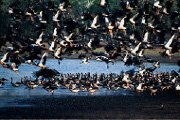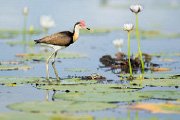Lockdown provides survey opportunities in Kakadu
Earlier this year Kakadu staff used the COVID-19 park closure as a rare opportunity to collect baseline data on the impacts of vehicle traffic on wildlife in Kakadu National Park.
Collisions between vehicles and animals are a significant cause of animal mortality within the park and dead animals on or by the side of the road (roadkill) are often seen throughout the park.
While the park was closed to outside visitors, the only vehicle movements in this traditionally high visitor season were of locals and essential services. With traffic significantly lower than usual a survey of roadkill was undertaken between April and June 2020.
The survey will be replicated during the same period in 2021 when visitors are anticipated to be back in the park and there would be tourist traffic.
The survey was undertaken by driving with a spotter along three 10 km stretches of road, on the Kakadu Highway, Arnhem Highway and Oenpelli Road. Data was collected three times a week over two months.
For each roadkill spotted data was collected on species, environmental characteristics (vegetation, weather, fire history, proximity to closest water crossing), position on road and road characteristics (surface, straight or bend, speed limit), condition of roadkill, observations of scavengers, and photos and measurements were also taken. Four traffic counters that already occur within the park provided the data on traffic levels.
A total of 57 roadkill sightings were made over 24 survey days across the three sites. The greatest proportion were found on the Arnhem Highway (68 per cent), with 21 per cent on Oenpelli Road and 11 per cent on the Kakadu Highway. The vertebrate group mostly impacted by vehicle strike were amphibians (39 per cent), followed by mammals (37 per cent), birds (16 per cent) and reptiles (9 per cent). The species most often found was the agile wallaby (32 per cent) and the cane toad (19 per cent). Kites were observed scavenging from 37 per cent of roadkill sightings.
After the follow-up survey in 2021, we will be able to compare the results from the two traffic scenarios (low and high tourist traffic) and gain a greater understanding of the impacts of tourist vehicles on the vertebrate species of Kakadu.
Take the first step
A journey of 1000 miles begins with a single click.
Enter your email to get free trip planning advice from Kakadu rangers.





